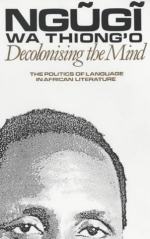
|
| Name: _________________________ | Period: ___________________ |
This test consists of 5 multiple choice questions, 5 short answer questions, and 10 short essay questions.
Multiple Choice Questions
1. What does the author refer to as the result of the broken harmony between the three aspects of language as communication for the colonial child?
(a) Colonial distinction.
(b) Colonial aberration.
(c) Colonial affectation.
(d) Colonial alienation.
2. Hausa is the first language of approximately how many people?
(a) 20 million.
(b) 44 million.
(c) 10 million.
(d) 36 million.
3. What does the Ituĩka ceremony mark?
(a) The birth of the first son in a family.
(b) The handing over of power from one generation to another.
(c) The onset of war.
(d) The marriage of an elder's son to a colonial daughter.
4. What statement largely sums up the author's central theme in Chapter 1, Part IV?
(a) Communication creates culture, and culture is a means of communication.
(b) Culture and communication are unnecessary.
(c) Culture creates communication, and communication is a means to culture.
(d) Culture reflects history and communication carries history.
5. The author states in Chapter 1, Part IX that "to the comprador-ruling regimes, their real enemy is" what (30)?
(a) "A democracy for and of the people."
(b) "An awakened peasantry and working class."
(c) "Themselves."
(d) "A socialist unity derived from commonality of purpose."
Short Answer Questions
1. On what date did the Kenya government ban any further performances of Ngaahika Ndeenda?
2. What does "Ngaahika Ndeenda" translate to in English?
3. What was the elitist institution for Africans in colonial Kenya where Ngũgĩ wa Thiong’o attended high school?
4. When did the Kamĩrĩĩthũ Community Education and Culture Center begin functioning?
5. Who wrote Facing Mount Kenya?
Short Essay Questions
1. What are the origins of drama, according to the author in Chapter 2, Part III?
2. What are the main characters anticipating in the opening of Ngaahika Ndeenda?
3. What does the author mean when he refers to the domination of the mental universe of the colonized?
4. Who is David Diop and what was his perspective on language?
5. When did Ngũgĩ wa Thiong’o cease writing in English? What were his first works in Gĩkũyũ?
6. What does the author ask about writers who continue to write in foreign languages in Chapter 1, Part VIII?
7. How are language and communication products of each other?
8. How does the author describe the significance of land in Kenya?
9. What are the three aspects of language as culture?
10. How does the author describe Kamĩrĩĩthũ? Where is it located? How many people live there?
|
This section contains 853 words (approx. 3 pages at 300 words per page) |

|




